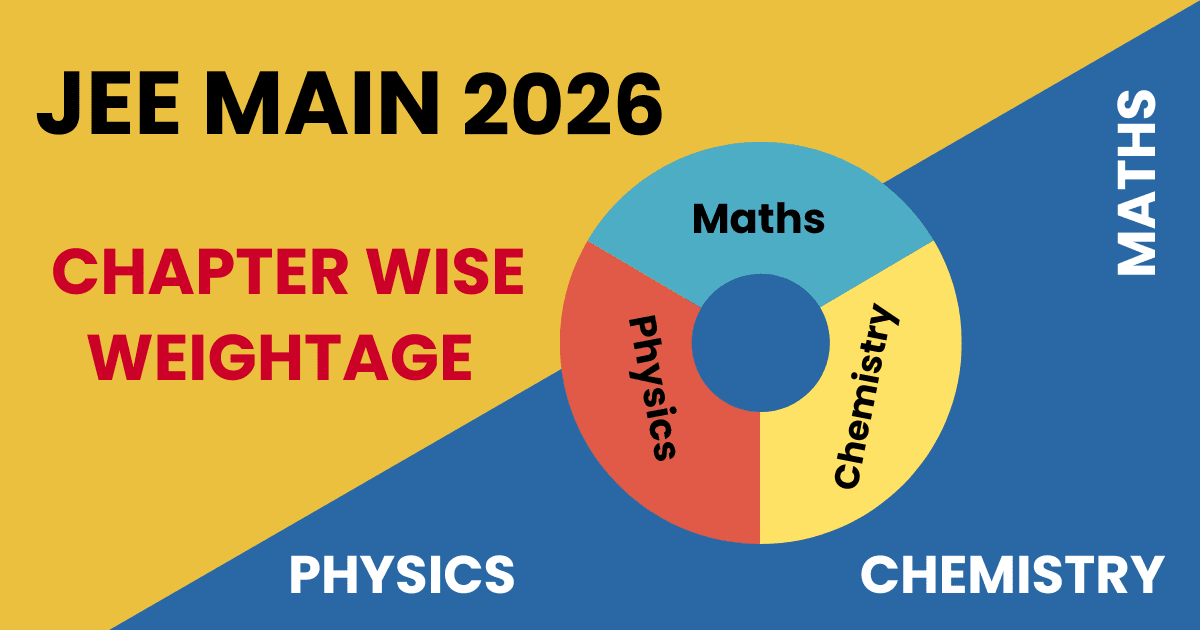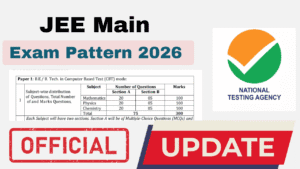The Joint Entrance Examination (JEE Main) 2026 is one of the most crucial exams for students aiming to enter India’s premier engineering institutes. With only a limited number of seats and intense competition, strategic preparation becomes essential.
A key aspect of that strategy is understanding chapter-wise weightage, the approximate distribution of marks among different chapters in Physics, Chemistry, and Mathematics.
Although the National Testing Agency (NTA) does not officially release topic-wise weightage, analyzing previous years’ papers provides clear trends. These insights help determine which chapters are consistently more important, guiding aspirants to focus their time and effort efficiently.
About the JEE Main 2026 Weightage Data
The following chapter-wise weightage for JEE Main 2026 is based on an in-depth review of previous years’ question papers, and expert analyses by leading educators. These figures represent an average trend, not an official breakdown, but they accurately reflect which chapters have carried higher importance over time.
The data serves as a practical roadmap to identify high-scoring chapters, plan revisions strategically, and focus on concepts that appear most frequently in the exam.
JEE Main 2026: Physics Chapterwise Weightage
Physics in JEE Main typically balances conceptual and numerical problems. While questions may come from across the syllabus, certain chapters repeatedly carry more weight.
Class 11 Physics
| Chapter | Approx. Weightage |
| Properties of Solids and Liquids | 9 % |
| Rotational Motion | 6.5 % |
| Physics and Measurement | 6 % |
| Kinematics | 4.5 % |
| Oscillations and Waves | 4.4 % |
| Thermodynamics | 4.5 % |
| Work, Energy, and Power | 4 % |
| Kinetic Theory of Gases | 2.5 % |
| Laws of Motion | 2 % |
| Gravitation | 2.7 % |
Class 12 Physics
| Chapter | Approx. Weightage |
| Optics | 13 % |
| Electrostatics | 10.7 % |
| Magnetism & Magnetic Effects of Current | 6 % |
| Current Electricity | 4.6 % |
| Atoms and Nuclei | 4.8 % |
| Dual Nature of Matter | 4 % |
| Electromagnetic Induction & AC | 3.8 % |
| Electronic Devices | 3.7 % |
| Electromagnetic Waves | 1.5 % |
| Experimental Skills | 0.6 % |
Insight:
Optics and Electrostatics are the most dominant chapters, together accounting for over one-fifth of the total marks in Physics. A strong understanding of theory, derivations, and formula application in these topics can significantly boost overall performance.
Is the JEE Main 2026 chapter-wise weightage officially released by NTA?
No. The National Testing Agency (NTA) does not officially publish chapter-wise or topic-wise weightage for JEE Main. The data is based on previous years’ paper analysis by experts and top coaching institutes. However, these trends are highly reliable and help identify high-scoring and frequently asked topics.
How should I prioritize chapters based on the JEE Main 2026 weightage?
Start with high-weightage chapters like Optics, Electrostatics, Thermodynamics, Coordination Compounds, and Coordinate Geometry.
Follow this strategy:
40% time on high-weight chapters
40% time on medium-weight chapters
20% time on low-weight chapters (for quick marks and confidence boost)
Can I skip low-weightage chapters in JEE Main 2026 preparation?
It’s not recommended. Even low-weight chapters may contribute 1–2 easy questions, which can make a 5–10 mark difference in your final score. Cover the basics of every topic while giving extra practice to high-weight areas.
Which chapters are most important in Physics for JEE Main 2026?
Based on past trends, Optics (13%), Electrostatics (10.7%), and Magnetism (6%) dominate the Physics section.
For Class 11, focus on Rotational Motion, Thermodynamics, and Kinematics — they often form the foundation for tougher Class 12 questions.
What are the most scoring chapters in Chemistry for JEE Main 2026?
Physical Chemistry: Thermodynamics, Electrochemistry, and Chemical Kinetics
Organic Chemistry: Basic Principles and Oxygen-containing Compounds
Inorganic Chemistry: Coordination Compounds and p-block Elements
A balanced preparation across all three sections is key for scoring high in Chemistry.
JEE Main 2026: Chemistry Chapterwise Weightage
Chemistry often acts as a scoring section due to its blend of conceptual, memory-based, and numerical questions. The paper generally balances Physical, Organic, and Inorganic Chemistry.
Class 11 Chemistry
| Chapter | Approx. Weightage |
| Some Basic Concepts of Chemistry | 7.8 % |
| Chemical Thermodynamics | 7 % |
| Some Basic Principles of Organic Chemistry | 6.3 % |
| Hydrocarbons | 5 % |
| Equilibrium | 5 % |
| Atomic Structure | 4.6 % |
| Chemical Bonding & Molecular Structure | 4.4 % |
| Classification of Elements (Periodic Table) | 4.4 % |
| Purification & Characterization of Organic Compounds | 2 % |
Class 12 Chemistry
| Chapter | Approx. Weightage |
| Coordination Compounds | 8.2 % |
| Redox Reaction & Electrochemistry | 6 % |
| Chemical Kinetics | 5 % |
| Solutions | 5.5 % |
| Organic Compounds Containing Oxygen | 5 % |
| p-Block Elements | 4.2 % |
| d- and f-Block Elements | 4 % |
| Biomolecules | 4.4 % |
| Polymers & Chemistry in Everyday Life | 2.5 % |
Insight:
Physical Chemistry chapters like Thermodynamics, Chemical Kinetics, and Electrochemistry frequently appear in the exam. Among Inorganic topics, Coordination Compounds and the p-block elements remain high-value areas.
In Organic Chemistry, chapters like Basic Principles and Oxygen-containing compounds yield reliable scores if concepts are clear.
JEE Main 2026: Maths Chapterwise Weightage
Mathematics requires both conceptual depth and time management. Certain topics consistently dominate the paper, while others provide quick scoring opportunities.
| Chapter | Approx. Weightage |
| Coordinate Geometry | 17–18 % |
| Integral Calculus | 10 % |
| Limits, Continuity, and Differentiability | 8.8 % |
| Sets, Relations, and Functions | 7.8 % |
| Sequence and Series | 7.3 % |
| Matrices and Determinants | 7 % |
| Probability and Statistics | 6 % |
| Vector Algebra | 4.8 % |
| Binomial Theorem | 4.2 % |
| 3D Geometry | 5 % |
| Differential Equations | 4 % |
| Trigonometry | 4.4 % |
| Complex Numbers | 3.5 % |
Insight:
Coordinate Geometry and Calculus together contribute nearly one-third of the Mathematics section. Strengthening problem-solving skills in these chapters, especially in Integration and Conic Sections, offers a significant advantage.
Chapters like Matrices, Probability, and Vectors are also essential due to their consistent 4–7 % share.
Also See: Is 75% Criteria Still Required for JEE Main 2026? Clarified by NTA
JEE Main 2026 Syllabus PDF Download
Updated Eligibility Criteria for JEE Main 2026
Where Will You Take JEE Main 2026? Find Out Here!
Which topics carry maximum weight in JEE Main 2026 Mathematics?
Coordinate Geometry (17–18%), Calculus (around 10%), and Limits & Differentiability (8.8%) are the top contributors.
Practicing previous year questions (PYQs) and mock tests from these areas can dramatically improve percentile scores.
How can chapter-wise weightage help improve my JEE Main percentile?
Knowing the weightage helps you study smart, not just hard. It allows you to:
Focus on high-return topics
Plan efficient revision cycles
Identify weak areas before mock tests
Reduce exam-time stress through targeted practice
Should I rely only on weightage for JEE Main 2026 preparation?
No. Weightage helps set priorities, but JEE questions can come from any part of the syllabus. Always aim for conceptual clarity in all topics, even if you allocate more practice time to high-weight ones.
How to Use JEE Main 2026 Chapterwise Weightage Smartly
- Prioritize high-weight chapters first:
Build strong conceptual clarity and practice multiple variations of problems. - Allocate time strategically:
Roughly 40 % of study hours should go to high-weight chapters, 40 % to medium ones, and 20 % to low-weight chapters. - Do not skip any chapter completely:
Low-weight topics often carry straightforward questions that can add a few extra marks easily. - Practice with mock tests:
Time-bound mock tests simulate the actual exam and highlight weak spots for improvement. - Focus on accuracy:
Even one or two negative marks can impact the percentile. Balanced speed and precision are key.
Conclusion
The JEE Main 2026 chapterwise weightage offers a clear roadmap for smart preparation. While exact percentages may vary slightly each year, consistent trends show that certain chapters, such as Optics, Electrostatics, Thermodynamics, Coordination Compounds, and Coordinate Geometry, carry a higher probability of appearing in the exam.
Using this data-driven approach helps plan revision cycles efficiently, ensuring that high-yield areas receive proper attention without neglecting the rest of the syllabus.
In a competitive exam like JEE Main, preparation is not just about hard work but also strategy. Understanding topic weightage, practicing regularly, and maintaining conceptual clarity remain the most effective steps toward achieving a high percentile in JEE Main 2026.








